Human mobility and resilience -
livelihood diversification strategies in the Nepali plains
By Asheshwor (ash)
asheshworman.shrestha@adelaide.edu.au,
PhD Candidate,
Geography, Environment & Population,
The University of Adelaide
1 September 2014
Overview
- Introduction
- Exposure to agricultural risks
- Perception and adaptation to climate change
- Human mobility
- Conclusion
1. Introduction
- Objective: To examine the linkage between perception of climate change impact to agriculture and changes in access to resources, and subsequent livelihood decisions
- Project background
- Field questionnaire survey (September 2013 - March 2014)
- Open-ended interviews (November 2013-March 2014)
- Climate data analysis daily records from 1970-2013 from 10 stations
Study locations
Study sites
Dhangadhi, Far-west Nepal
Damak, East Nepal
Background on Nepali plains - the Tarai
- Destination of in-migrants moving from the hills
- Tarai has witnessed massive socio-ecological change
- Forest clearing and malaria eradication
- Agricultural extensification to feed the nation
- Urbanization
- Tarai is also seen as a region neglected by the central government (Majumdar 2006)
Household characteristics
| Damak | Dhangadhi | |
| Sample households | 143 | 151 |
| Total households | 3,989 | 4,624 |
| Total population in selected wards | 15,909 | 25,726 |
| Mean age of respondents, respondents' family | 45.15 , 34.11 | 39.6, 25.62 |
| Gender distribution | M 75.5%; F 24.5% | M 43.0%; F 56.9% |
| Livestock ownership | 68.53% | 96.69% |
| Involvement in agriculture | 77.62% | 90.07% |
| HH with migrant worker | 49.65% | 56.28% |
| HH w/ flood experience | 49.65% | 56.29% |
| HH's median land area in sq. m. | 6,773 | 4,741 |
| Median household size | 5 | 6 |
| Median number of mobile phones per HH | 2 | 2 |
Cooking fuel
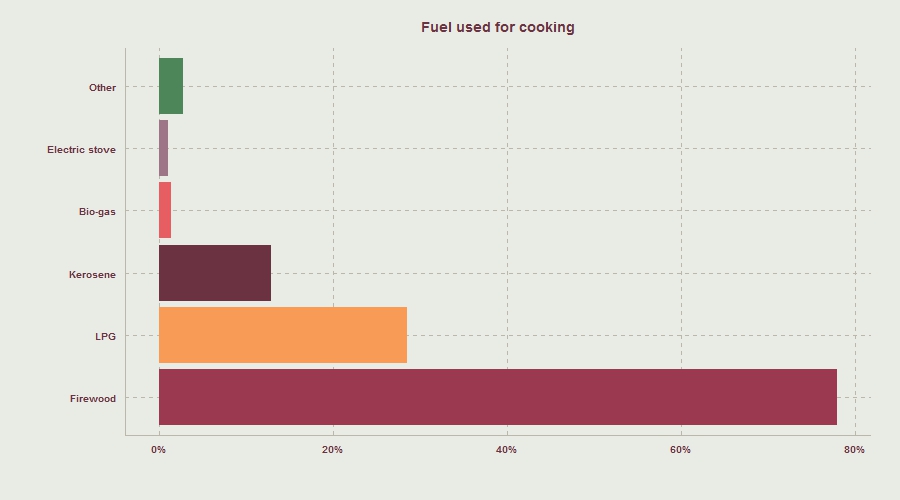
Firewood was the most popular fuel for cooking used by 77% of households
2. Exposure to agricultural risks
- High inter-annual variability in rainfall
- Agricultural infrastructure has not been modernized
- Frequent flash floods
Rainfall variability
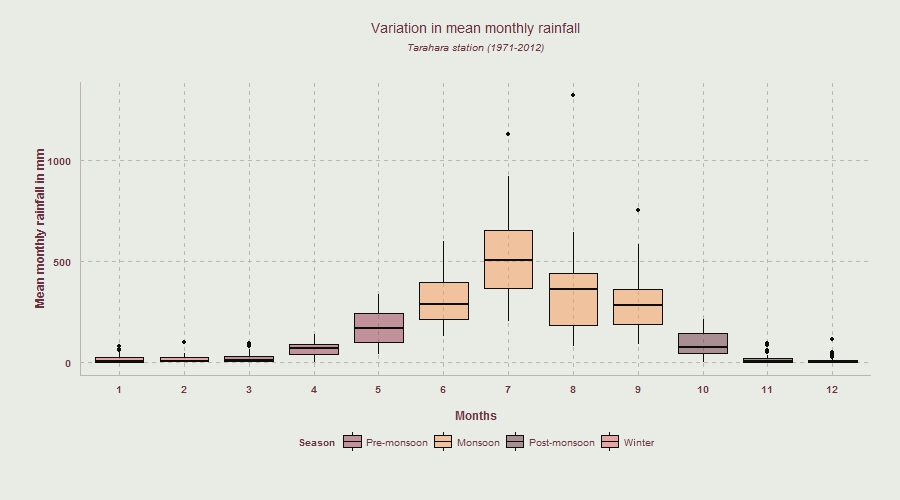
Inter-annual variability in mean monthly rainfall in Tarahara Station (1971 - 2012 aggregate)
Rainfall variability during monsoon
- Monsoon onset day:
any rainy day after 1st June with total rainfall of three consecutive days exceeding 30 mm. A day is counted as a rainy day if there is a rainfall of at least 0.85 mm - Dry spell days:
at least 7 consecutive days of no rainfall after commencement of monsoon - Successful plantation days:
no dry-spell days in 30 days after the monsoon onset date (Karmacharya 2010)
Monsoon onset day and dry spell days
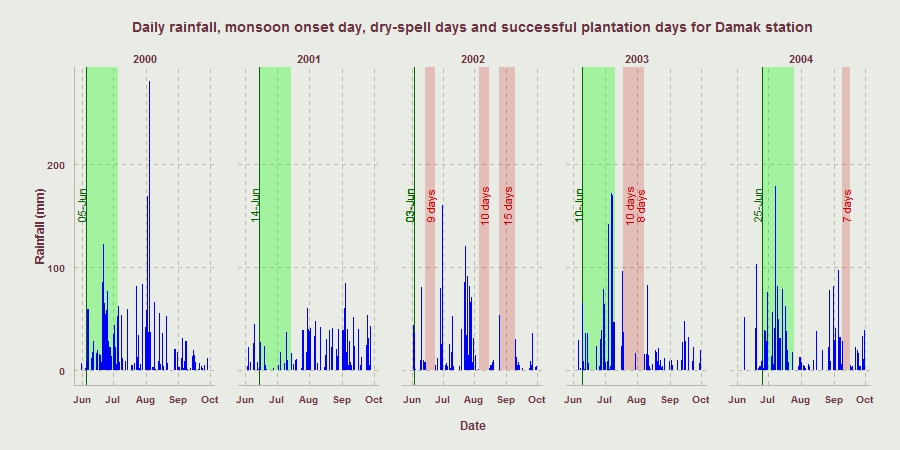
Dry spell days, monsoon onset day and successful plantation day for Damak station for years 2000 to 2004
Monsoon onset day and dry spell days

Cropping calendar
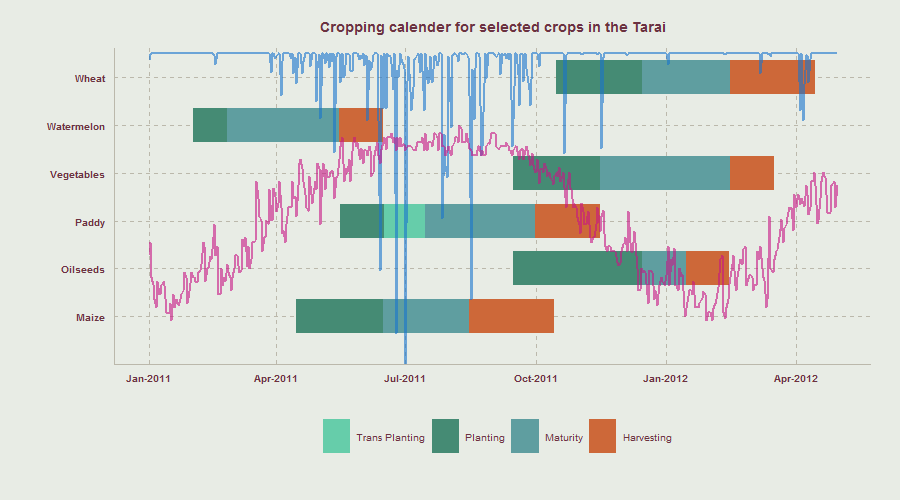
Cropping calendar for major crops in Tarai showing daily rainfall (blue) and daily minimum temperature (magenta)
Agricultural infrastructure
- Canal system: only small percentage with access to canals, and the structure has not been properly maintained
- Electricity: supply is not constant, up to 18 hours per day load shedding
- Cost barrier: cost of pump, cost of bore hole, cost of fuel (electricity/petrol/diesel) and cost of pipe
- Only 3 respondents out of 294 had started harvesting a new crop in the last 5 years
- Marginalized communities have been left out of the decision making process in resource management including community forestry (Gauli & Rishi 2004)
Flash floods
- Sediment deposit on the field was the most reported problem from floods
- No mechanism for compensation when land is lost
- Only 18 respondents had received any form of relief
- No insurance mechanism
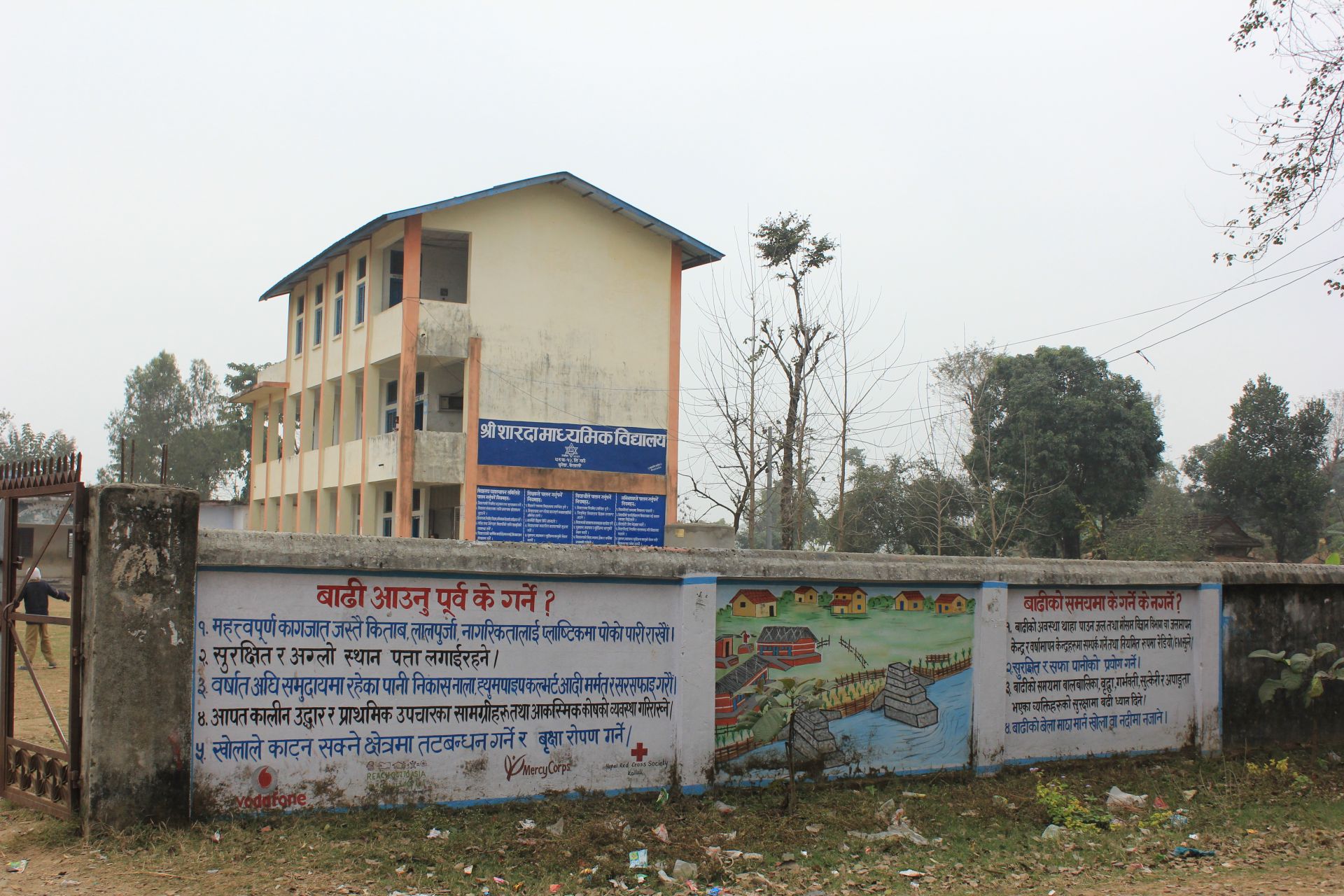
3. Perception and adaptation
- Perception of climate change
- Perception of trends in agricultural output
- In-situ adaptation examples
Perception of climate change

Impact from climatic variables

Perception of trends in agricultural output
Adaptation responses
"Nothing can be done"
(6 respondents in questionnaire survey)
"When the field was dry, land owner accused me of not working hard enough. Pump set is not available when needed."
(female-25 from Dhangadhi, 3 Feb 2014)
"Rainfall is best. Pumped water do not contain vitamins."
(female-33 from Dhangadhi, 3 Feb 2014)
In-situ adaptation examples
- Farming of high value crops along the river banks when it is dry
- Requires constant safeguard
- No legal entitlement
- Prone to flooding
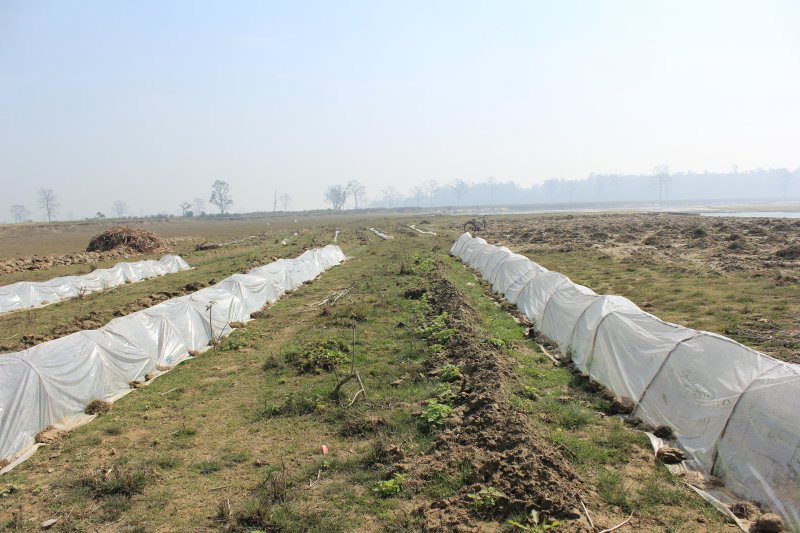
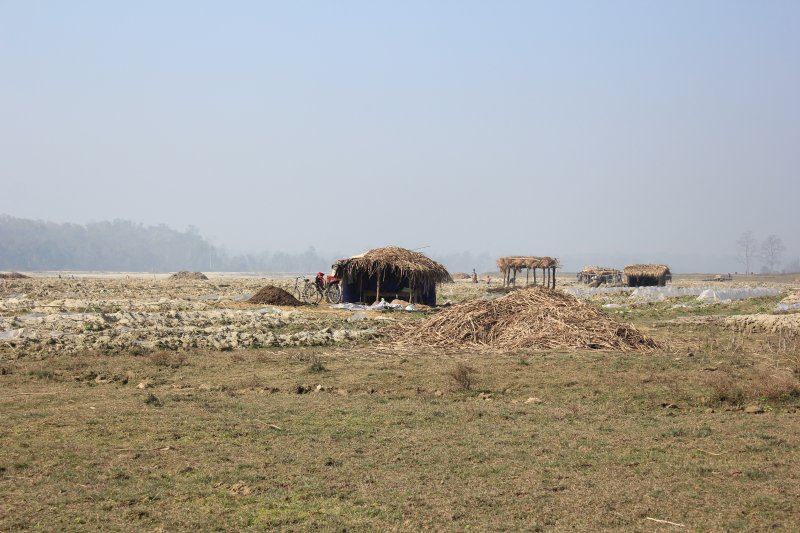
In-situ adaptation examples
- Procuring fodder and firewood
- Forests in the Tarai are highly protected now compared to in the past when it used to be a common pool resource
- Not all families can afford the payment and have resorted to fetching firewood from across the border
- During flooding period, locals collect trees and branches brought by the flood.

In-situ adaptation examples
- Hiring paid labour for agriculture
- Labour from outside of family needed
- Upfront investment for planting, transplanting and harvesting labour


4. Human mobility in the Tarai
- Contemporary destinations
- Demographics
- Income
- Migration characteristics
Contemporary destinations for migrant workers

Destination regions of migrant members from surveyed households
Migrants' age, education and years in foreign employment
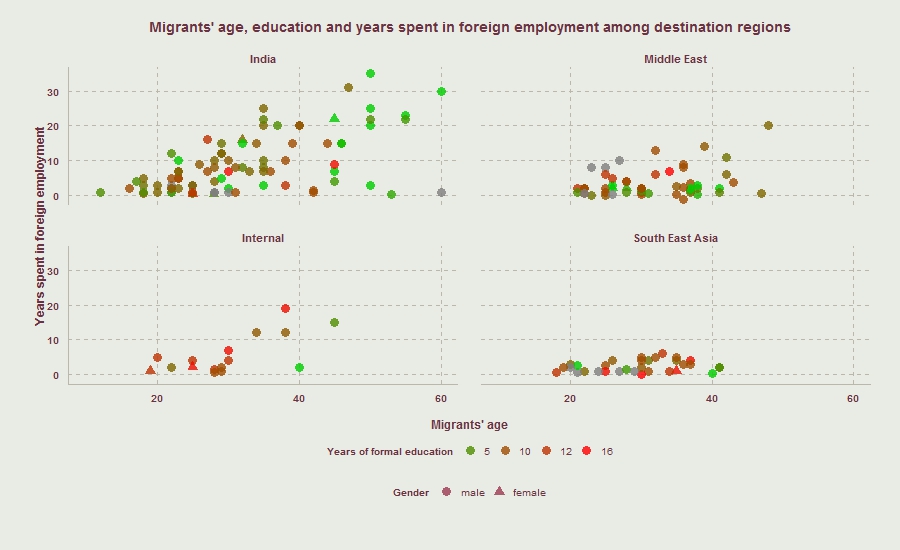
Formal education of migrants

Remittances by destination
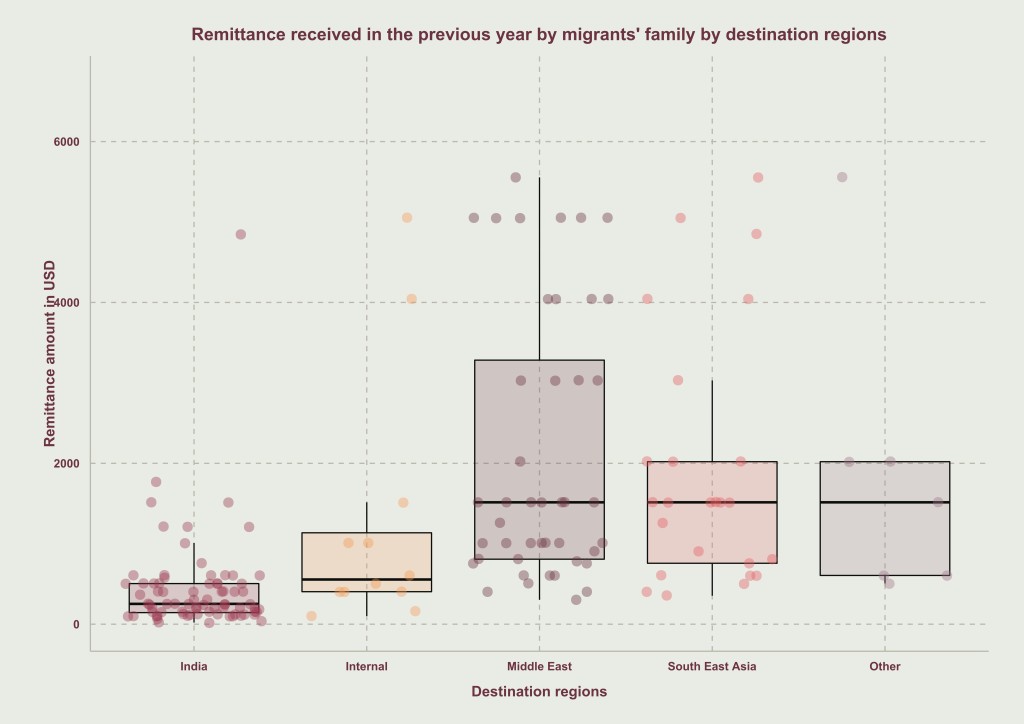
National GPD per capita for 2012 was USD 694 (World Bank, 2014)
Use of remittances
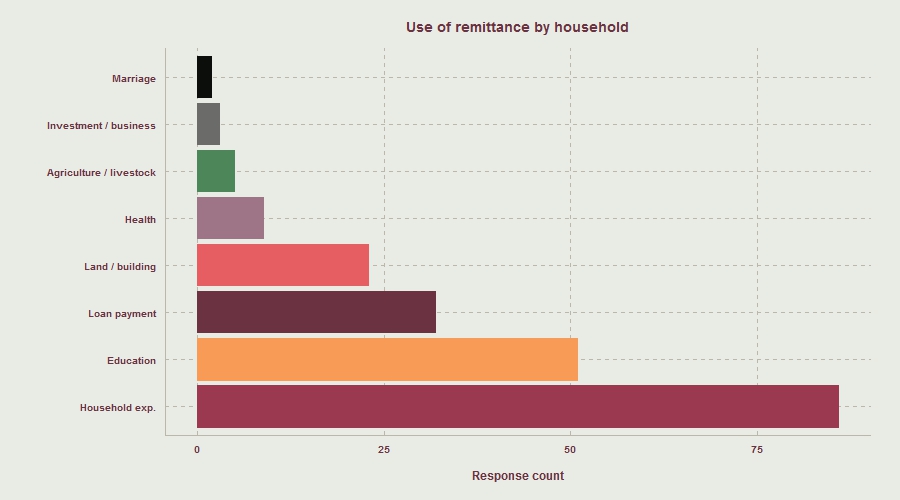
Migration characteristics summary
- Significant difference in education among the migrants going to India and the Middle East compared to internal migrants and migrants going to SE Asia
- Since the use of remittances for basic household activities and the fact that remittance income is disproportionately larger than income made at home, the trend in foreign employment is expected to continue
- Remittances not only provide a supplemental income for households but also enable marginalized household to contest the existing social and cultural norms (Sunam 2014)
5. Conclusion
- Tarai’s agricultural system has been under stress from the environment and its inability to modernize
- In a continual attempt to seek for new ways to adapt, farmers are looking for on-farm and off-farm solutions which is increasingly becoming global
- Migration has been recognized as adaptation (Black et al. 2011; Black, Kniveton & Schmidt-Verkerk 2011)
- It calls for rethinking adaptation in terms of the extent of adjustment that the societal system will change to become resilient (Bardsley, 2014) and begs inclusion of migration in adaptation policies
Discussion
Questions / comments
Acknowledgements
- Field-work funding from Department of Geography, Environment & Population, University of Adelaide
- Field research assistants Shreekrishna Chaudhary and Sujan Ranjitkar
- Local contact persons - Umesh Dhimal, Tejpal Dhimal, Laxmi Niraula and Kanchan Ojha
- Special thanks to Damak Municipality, Dhangadhi Municipality, Mercycorps Nepal, ADF Nepal Pvt. Ltd., and Neeraj Dangol
A shorter version of this presentation will be delivered at
Climate Adaptation 2014: Future Challenges conference on
2nd October 2014 at Gold Coast, Australia
References
- Bardsley, D. K. 2014, 'Limits to adaptation or a second modernity? Responses to climate change risk in the context of failing socio-ecosystems, Environmental Development & Sustainability, DIO 10.1007/s10668-014-9541-x
- Black, R, Bennett, SRG, Thomas, SM & Beddington, JR 2011, 'Migration as adaptation', Nature Climate Change, vol. 478. Black, R, Kniveton, D & Schmidt-Verkerk, K 2011, 'Migration and climate change: towards and integrated assessment of sensitivity', Environment and Planning A, vol. 73, pp. 431-450.
- Gauli, K & Rishi, P 2004, 'Do the marginalised class really participate in community forestry? A case study from western Terai region of Nepal', Forests Trees and Livelihoods, vol. 14, no. 2-4
- Karmacharya, J 2010, Exploring daily rainfall data to investigate evidence of climate change in Kathmandu Valley and its implication in rice farming in the area, Ministry of Agriculture, Kathmandu, Nepal.
- Majumdar, M 2006, 'धनी ठाऊँ, गरिब अर्थतन्त्र (Rich place, poor economy)', in M Mainali & B Thapa (eds), मधेस: समस्या र संभावना (Madhesh: challanges and opportunities), Social Science Baha, Himal Association, Lalitpur, Nepal, pp. 29-40.
- Sunam, R 2014, 'Marginalised Dalits in International Labour Migration: Reconfiguring Economic and Social Relations in Nepal', Journal of Ethnic and Migration Studies.
- World Bank 2014, 'World Bank development indicators', URL: http://data.worldbank.org/indicator/NY.GDP.PCAP.CD/countries accessed 3-08-2014